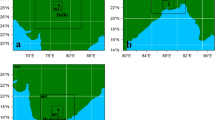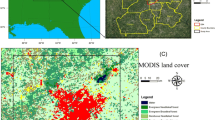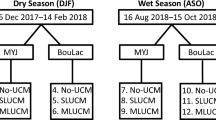Abstract
Urban heat island effect in Delhi has been assessed using Weather Research and Forecasting (WRF v3.5) coupled with urban canopy model (UCM) focusing on air temperature and surface skin temperature. The estimated heat island intensities for different land use/land cover (LULC) have been compared with those derived from in situ and satellite observations. The model performs reasonably well for urban heat island intensity (UHI) estimation and is able to reproduce trend of UHI for urban areas. There is a significant improvement in model performance with inclusion of UCM which results in reduction in root mean-squared errors (RMSE) for temperatures from 1.63 °C (2.89 °C) to 1.13 °C (2.75 °C) for urban (non-urban) areas. Modification of LULC also improves performance for non-urban areas. High UHI zones and top 3 hotspots are captured well by the model. The relevance of selecting a reference point at the periphery of the city away from populated and built-up areas for UHI estimation is examined in the context of rapidly growing cities where rural areas are transforming fast into built-up areas, and reference site may not be appropriate for future years. UHI estimated by WRF model (with and without UCM) with respect to reference rural site compares well with the UHI based on observed in situ data. An alternative methodology is explored using a green area with minimum temperature within the city as a reference site. This alternative methodology works well with observed UHIs and WRF-UCM-simulated UHIs but has poor performance for WRF-simulated UHIs. It is concluded that WRF model can be applied for UHI estimation with classical methodology based on rural reference site. In general, many times WRF model performs satisfactorily, though WRF-UCM always shows a better performance. Hence, inclusion of appropriate representation of urban canopies and land use–land cover is important for improving predictive capabilities of the mesoscale models.











Similar content being viewed by others
References
Borge R, Alexandrov V, José del Vas J, Lumbreras J, Rodríguez E (2008) A comprehensive sensitivity analysis of the WRF model for air quality applications over the Iberian Peninsula. Atmos Environ 42:8560–8574. doi:10.1016/j.atmosenv.2008.08.032
Chen F et al (2011a) The integrated WRF/urban modelling system: development, evaluation, and applications to urban environmental problems. Int J Climatol 31:273–288. doi:10.1002/joc.2158
Chen F, Miao S, Tewari M, Bao J-W, Kusaka H (2011b) A numerical study of interactions between surface forcing and sea breeze circulations and their effects on stagnation in the greater Houston area. Journal of Geophysical Research 116. doi:10.1029/2010jd015533
Chen F, Yang X, Zhu W (2014) WRF simulations of urban heat island under hot-weather synoptic conditions: the case study of Hangzhou City, China. Atmos Res 138:364–377. doi:10.1016/j.atmosres.2013.12.005
Ching JKS (2013) A perspective on urban canopy layer modeling for weather, climate and air quality applications. Urban Climate 3:13–39. doi:10.1016/j.uclim.2013.02.001
Cox R, Bauer BL, Smith T (1998) A mesoscale model intercomparison. Bull Am MeteorolSoc 79:265–283. doi:10.1175/1520-0477(1998)079<0265:AMMI>2.0.CO;2
Das PK (1968) The monsoons. National Book Trust, India
Ding H, Shi W (2013) Land-use/land-cover change and its influence on surface temperature: a case study in Beijing City. Int J Remote Sens 34:5503–5517. doi:10.1080/01431161.2013.792966
Dudhia J (1989) Numerical study of convection observed during the winter monsoon experiment using a mesoscale two-dimensional model. J Atmos Sci 46:3077–3107. doi:10.1175/1520-0469(1989)046<3077:NSOCOD>2.0.CO;2
Emery C, Tai E, Yardwood G (2001) Enhanced meteorological modeling and performance evaluation for two Texas ozone episodes. Environ International Corporation. http://www.tceq.state.tx.us/assets/public/implementation/air/am/contracts/reports/mm/EnhancedMetModelingAndPerformanceEvaluation.pdf. Accessed 15 October 2014
Emmanuel R, Krüger E (2012) Urban heat island and its impact on climate change resilience in a shrinking city: the case of Glasgow, UK. Build Environ 53:137–149. doi:10.1016/j.buildenv.2012.01.020
Fallmann J (2013) Modeling of the urban heat island (UHI) using WRF—assessment of adaptation and mitigation strategies for the city of Stuttgart. Paper presented at the EGU General Assembly Conference Abstracts, 2013
Flaounas E, Bastin S, Janicot S (2011) Regional climate modelling of the 2006 West African monsoon: sensitivity to convection and planetary boundary layer parameterisation using WRF. Clim Dyn 36:1083–1105. doi:10.1007/s00382-010-0785-3
Giannaros TM, Melas D, Daglis IA, Keramitsoglou I, Kourtidis K (2013) Numerical study of the urban heat island over Athens (Greece) with the WRF model. Atmos Environ 73:103–111. doi:10.1016/j.atmosenv.2013.02.055
Gilliam RC, Pleim JE (2010) Performance assessment of new land surface and planetary boundary layer physics in the WRF-ARW. J Appl Meteorol Climatol 49:760–774. doi:10.1175/2009JAMC2126.1
Giovanni (2014) Monsoon Asia Integrated Regional Study. National Aeronautics and Space Administration. http://gdata1.sci.gsfc.nasa.gov/daac-bin/G3/gui.cgi?instance_id=mairs_8day. Accessed 27 December 2014
Gupta M, Mohan M (2013) Assessment of contribution to PM10 concentrations from long range transport of pollutants using WRF/Chem over a subtropical urban airshed. Atmospheric Pollution Research 4:405–410. doi:10.5094/APR.2013.046
Hernández-Ceballos MA, Adame JA, Bolívar JP, De la Morena BA (2013) A mesoscale simulation of coastal circulation in the Guadalquivir valley (southwestern Iberian Peninsula) using the WRF-ARW model. Atmos Res 124:1–20. doi:10.1016/j.atmosres.2012.12.002
Hu X-M, Klein PM, Xue M, Lundquist JK, Zhang F, Qi Y (2013) Impact of low-level jets on the nocturnal urban heat island intensity in Oklahoma City. J Appl Meteorol Climatol 52:1779–1802. doi:10.1175/JAMC-D-12-0256.1
Huang X-Y et al (2009) Four-dimensional variational data assimilation for WRF: formulation and preliminary results. Mon Weather Rev 137:299–314. doi:10.1175/2008MWR2577.1
Imhoff ML, Zhang P, Wolfe RE, Bounoua L (2010) Remote sensing of the urban heat island effect across biomes in the continental USA. Remote Sens Environ 114:504–513. doi:10.1016/j.rse.2009.10.008
Jin MS (2012) Developing an index to measure urban heat island effect using satellite land skin temperature and land cover observations. J Clim 25:6193–6201. doi:10.1175/JCLI-D-11-00509.1
Kain JS (2004) The Kain–Fritsch convective parameterization: an update. J Appl Meteorol 43:170–181. doi:10.1175/1520-0450(2004)043<0170:TKCPAU>2.0.CO;2
Keramitsoglou I, Kiranoudis CT, Ceriola G, Weng Q, Rajasekar U (2011) Identification and analysis of urban surface temperature patterns in Greater Athens, Greece, using MODIS imagery. Remote Sens Environ 115:3080–3090. doi:10.1016/j.rse.2011.06.014
Khandelwal S, Goyal R, Kaul N (2010) Study of seasonal and spatial pattern of urban heat island of Jaipur City and its relationship with enhanced vegetation index. 13th Annual International Conference and Exhibition on Geospatial Information Technology and Applications. http://mapindia.org/2010/proceeding/pdf/186.pdf. Accessed 14 August 2014
Kim Y, Sartelet K, Raut J-C, Chazette P (2013) Evaluation of the weather research and forecast/urban model over greater Paris. Boundary-Layer Meteorol 149:105–132. doi:10.1007/s10546-013-9838-6
Kolokotroni M, Giannitsaris I, Watkins R (2006) The effect of the London urban heat island on building summer cooling demand and night ventilation strategies. Sol Energy 80:383–392. doi:10.1016/j.solener.2005.03.010
Kolokotroni M, Ren X, Davies M, Mavrogianni A (2012) London’s urban heat island: impact on current and future energy consumption in office buildings. Energy Build 47:302–311. doi:10.1016/j.enbuild.2011.12.019
Kondo H, Genchi Y, Kikegawa Y, Ohashi Y, Yoshikado H, Komiyama H (2005) Development of a multi-layer urban canopy model for the analysis of energy consumption in a big city: structure of the urban canopy model and its basic performance. Boundary-Layer Meteorol 116:395–421. doi:10.1007/s10546-005-0905-5
Kusaka H, Kimura F (2004) Coupling a single-layer urban canopy model with a simple atmospheric model: impact on urban heat island simulation for an idealized case. Journal of the Meteorological Society of Japan Ser II 82:67–80. doi:10.2151/jmsj.82.67
Kusaka H et al (2012a) Numerical simulation of urban heat island effect by the WRF model with 4-km grid increment: an inter-comparison study between the urban canopy model and slab model. Journal of the Meteorological Society of Japan Ser II 90B:33–45. doi:10.2151/jmsj.2012-B03
Kusaka H, Hara M, Takane Y (2012b) Urban climate projection by the WRF model at 3-km horizontal grid increment: dynamical downscaling and predicting heat stress in the 2070’s August for Tokyo, Osaka, and Nagoya metropolises. Journal of the Meteorological Society of Japan Ser II 90B:47–63. doi:10.2151/jmsj.2012-B04
Lee CB, Kim JC, Jang YJ (2012) A study of urban heat island in Chuncheon using WRF model and field measurements. Journal of Korean Society for Atmospheric Environment 28:119–130. doi:10.5572/KOSAE.2012.28.2.119
Leung LR, Qian Y (2009) Atmospheric rivers induced heavy precipitation and flooding in the western U.S. simulated by the WRF regional climate model. Geophys Res Lett 36:L03820. doi:10.1029/2008GL036445
Lin Y-L, Farley RD, Orville HD (1983) Bulk parameterization of the snow field in a cloud model. J Clim Appl Meteorol 22:1065–1092. doi:10.1175/1520-0450(1983)022<1065:BPOTSF>2.0.CO;2
Martin P, Baudouin Y, Gachon P (2014) An alternative method to characterize the surface urban heat island. Int J Biometeorol:1–13. doi: 10.1007/s00484-014-0902-9
Masson V (2000) A physically-based scheme for the urban energy budget in atmospheric models. Bound Layer Meteorol 94:357–397. doi:10.1023/A:1002463829265
Meng WG, Zhang YX, Li JN, Lin WS, Dai GF, Li HR (2011) Application of WRF/UCM in the simulation of a heat wave event and urban heat island around Guangzhou. J Trop Meteorol 17:257–267
Mlawer EJ, Taubman SJ, Brown PD, Iacono MJ, Clough SA (1997) Radiative transfer for inhomogeneous atmospheres: RRTM, a validated correlated-k model for the longwave. J Geophys Res: Atmos 102:16663–16682. doi:10.1029/97JD00237
Mohan M, Bhati S (2011) Analysis of WRF model performance over subtropical region of Delhi, India. AdvMeteorol 2011 doi: 10.1155/2011/621235
Mohan M, Kikegawa Y, Gurjar BR, Bhati S, Kandya A, Ogawa K (2012) Urban heat island assessment for a tropical urban airshed in India. Atmos Clim Sci 2:12. doi:10.4236/acs.2012.22014
Mohan M, Kikegawa Y, Gurjar BR, Bhati S, Kolli N (2013) Assessment of urban heat island effect for different land use–land cover from micrometeorological measurements and remote sensing data for megacity Delhi. Theor Appl Climatol 112:647–658. doi:10.1007/s00704-012-0758-z
Myrup LO (1969) A numerical model of the urban heat island. J Appl Meteorol 8:908–918. doi:10.1175/1520-0450(1969)008<0908:ANMOTU>2.0.CO;2
NCAR (2013) User’s guide for the advanced research WRF (ARW) modeling system version 3.5. http://www2.mmm.ucar.edu/wrf/users/docs/user_guide_V3/contents.html. Accessed 13 June 2013
Oke TR (1969) Towards a more rational understanding of the urban heat island. McGill Climatol Bull 5:1–21
Oke TR (1973) City size and the urban heat island. Atmos Environ (1967) 7:769–779. doi:10.1016/0004-6981(73)90140-6
Oke TR (1982) The energetic basis of the urban heat island. Q J Roy Meteorol Soc 108:1–24. doi:10.1002/qj.49710845502
Oleson KW, Bonan GB, Feddema J, Vertenstein M, Grimmond CSB (2008) An urban parameterization for a global climate model. Part I: formulation and evaluation for Two cities. J Appl Meteorol Climatol 47:1038–1060. doi:10.1175/2007JAMC1597.1
Pleim JE (2006) A simple, efficient solution of flux–profile relationships in the atmospheric surface layer. J Appl Meteorol Climatol 45:341–347. doi:10.1175/JAM2339.1
Pleim JE (2007) A combined local and nonlocal closure model for the atmospheric boundary layer. Part I: model description and testing. J Appl Meteorol Climatol 46:1383–1395. doi:10.1175/JAM2539.1
Porson A, Clark PA, Harman IN, Best MJ, Belcher SE (2010) Implementation of a new urban energy budget scheme in the MetUM. Part I: description and idealized simulations. Q J Roy Meteorol Soc 136:1514–1529. doi:10.1002/qj.668
Ramachandra TV, Kumar U (2010) Greater Bangalore: emerging urban heat island. GIS Development.http://www.ces.iisc.ernet.in/energy/paper/Bangalore_heatisland/index.htm. Accessed 27 Jul 2011
Ran L, Pleim J, Gilliam R (2010) Impact of high resolution land-use data in meteorology and air quality modeling systems. In: Steyn DG, Rao ST (eds) Air Pollution Modeling and its Application XX. Springer, Netherlands, pp 1–108. doi:10.1007/978-90-481-3812-8_1
Ren GY, Chu ZY, Chen ZH, Ren YY (2007) Implications of temporal change in urban heat island intensity observed at Beijing and Wuhan stations. Geophys Res Lett 34:L05711. doi:10.1029/2006GL027927
Santamouris M (2015) Analyzing the heat island magnitude and characteristics in one hundred Asian and Australian cities and regions. Sci Total Environ 512–513:582–598. doi:10.1016/j.scitotenv.2015.01.060
Sarrat C, Lemonsu A, Masson V, Guedalia D (2006) Impact of urban heat island on regional atmospheric pollution. Atmos Environ 40:1743–1758. doi:10.1016/j.atmosenv.2005.11.037
Shimadera H, Kondo A, Shrestha KL, Kaga A, Inoue Y (2011) Annual sulfur deposition through fog, wet and dry deposition in the Kinki Region of Japan. Atmos Environ 45:6299–6308. doi:10.1016/j.atmosenv.2011.08.055
Skamarock WC, Klemp JB, Dudhia J, Gill DO, Barker DM, Wang W, Powers JG. 2005. A description of the advanced research WRF version 2. NCAR Technical Note TN-468 + STR, 88 [Available from NCAR, P. O. Box 3000, Boulder, CO 80307
Steeneveld GJ, Koopmans S, Heusinkveld BG, van Hove LWA, Holtslag AAM (2011) Quantifying urban heat island effects and human comfort for cities of variable size and urban morphology in the Netherlands. J Geophys Res: Atmos 116:D20129. doi:10.1029/2011JD015988
Stewart ID (2011) A systematic review and scientific critique of methodology in modern urban heat island literature. Int J Climatol 31:200–217. doi:10.1002/joc.2141
Stewart ID, Oke TR (2009) A new classification system for urban climate sites. Bull Am Meteorol Soc 90:922–923
Stewart ID, Oke TR (2010) Thermal differentiation of local climate zones using temperature observations from urban and rural field sites. Ninth Symposium on Urban Environment, Keystone, CO, https://ams.confex.com/ams/pdfpapers/173127.pdf . Accessed 14 October 2014
Sundersingh SD (1990) Effect of heat islands over urban madras and measures for its mitigation. Energy Build 15:245–252. doi:10.1016/0378-7788(90)90136-7
Taha H (1997) Urban climates and heat islands: albedo, evapotranspiration, and anthropogenic heat. Energy and Buildings 25:99–103. doi:10.1016/S0378-7788(96)00999-1
Tan J et al (2010) The urban heat island and its impact on heat waves and human health in Shanghai. Int J Biometeorol 54:75–84. doi:10.1007/s00484-009-0256-x
Tewari M, Chen F, Wang W, Dudhia J, LeMone MA, Mitchell K, Ek M, Gayno G, Wegiel J, Cuenca RH (2004) Implementation and verification of the unified NOAH land surface model in the WRF model. 20th conference on weather analysis and forecasting/16th conference on numerical weather prediction, 11–15.
Tewari MF, Chen F, Kusaka H, Miao S (2007) Coupled WRF/Unified Noah/urban-canopy modeling system. NCAR WRF Documentation, NCAR, Boulder, pp 1–20, Available online at http://www.ral.ucar.edu/research/land/technology/urban/WRF-LSM-Urban.pdf
Tie X et al (2007) Characterizations of chemical oxidants in Mexico City: a regional chemical dynamical model (WRF-Chem) study. Atmos Environ 41:1989–2008. doi:10.1016/j.atmosenv.2006.10.053
Vázquez S, López Á, Souto JA, Casares JJ (2014) Validation of WRF model during O3 episodes in an Atlantic coastal region. In: Steyn DG, Builtjes PJH, Timmermans RMA (eds) Air pollution modeling and its application XXII. NATO Science for Peace and Security Series C: Environmental Security. Springer Netherlands, pp 599–603. doi:10.1007/978-94-007-5577-2_101
Wang X, Chen MF, Wu ZY, Zhang MG, Tewari M, Guenther A, Wiedinmyer C (2009) Impacts of weather conditions modified by urban expansion on surface ozone: comparison between the Pearl River Delta and Yangtze River Delta regions. Adv Atmos Sci 26:962–972. doi:10.1007/s00376-009-8001-2
Wang Z-H, Bou-Zeid E, Smith JA (2013) A coupled energy transport and hydrological model for urban canopies evaluated using a wireless sensor network. Q J Roy Meteorol Soc 139:1643–1657. doi:10.1002/qj.2032
Weng Q, Lu D, Schubring J (2004) Estimation of land surface temperature–vegetation abundance relationship for urban heat island studies. Remote Sens Environ 89:467–483. doi:10.1016/j.rse.2003.11.005
WMO (2008) Overview of tools and methods for meteorological and air pollution mesoscale model evaluation and user training. GAW Report No. 181. ftp://ftp.wmo.int/Documents/PublicWeb/arep/gaw/gaw181final_18dec08.pdf. Accessed 14 October 2014
Yuan F, Bauer ME (2007) Comparison of impervious surface area and normalized difference vegetation index as indicators of surface urban heat island effects in Landsat imagery. Remote Sens Environ 106:375–386. doi:10.1016/j.rse.2006.09.003
Zhang H, Sato N, Izumi T, Hanaki K, Aramaki T (2008) Modified RAMS-urban canopy model for heat island simulation in Chongqing, China. J Appl Meteorol Climatol 47:509–524. doi:10.1175/2007jamc1397.1
Zhang Y, Wen XY, Jang CJ (2010) Simulating chemistry–aerosol–cloud–radiation–climate feedbacks over the continental U.S. using the online-coupled Weather Research Forecasting Model with chemistry (WRF/Chem). Atmos Environ 44:3568–3582. doi:10.1016/j.atmosenv.2010.05.056
Acknowledgments
The present study is a part of a research project “Implementation and Validation of Numerical Models for Heat Island Studies in Mega-city Delhi” conducted jointly by IIT Delhi, IIT Roorkee (Prof. B.R. Gurjar), and Meisei University, Tokyo (Prof. Y. Kikegawa). We thank The Ministry of Education, Culture, Sports, Science and Technology (MEXT), Japan for the partial financial support. We thank the participants of the field campaign from IIT Delhi, IIT Roorkee, and Meisei University. Some of the analyses in this study were based on data which were acquired as part of the NASA’s Earth-Sun System Division and archived and distributed by the Goddard Earth Sciences (GES) Data and Information Services Center (DISC) Distributed Active Archive Center (DAAC). The authors would like to thank the anonymous reviewers for constructive suggestions that have helped in improving the quality of the paper.
Author information
Authors and Affiliations
Corresponding author
Rights and permissions
About this article
Cite this article
Bhati, S., Mohan, M. WRF model evaluation for the urban heat island assessment under varying land use/land cover and reference site conditions. Theor Appl Climatol 126, 385–400 (2016). https://doi.org/10.1007/s00704-015-1589-5
Received:
Accepted:
Published:
Issue Date:
DOI: https://doi.org/10.1007/s00704-015-1589-5




